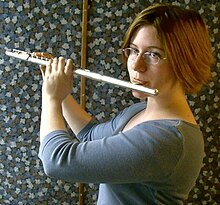Flute/Embouchure and Producing Sound
Method book for those beginning to learn flute.
Introduction
Introduction • Maintenance
Getting started
Lesson 2 • Lesson 3 • Lesson 4 • Lesson 5 • Lesson 6
Playing the flute
Lesson 7 • Lesson 8 • Lesson 9 • Lesson 10 • Lesson 11 • Lesson 12 • Lesson 13 • Lesson 14
Building on skills
Lesson 15 • Lesson 16 • Lesson 17 • Lesson 18 • Lesson 19 • Lesson 20 • Lesson 21 • Lesson 22 • Culmination
Appendicies
Links • Learning a piece of music
Related books
Saxophone • Music Theory • Baroque Flute Handbook • Western Music History
The word bouche is French for mouth. Wind musicians use embouchure to describe the shape of their lips as they play a musical instrument. The embouchure hole refers to the hole in the mouthpiece (or headjoint) of the instrument.
Finding a practicable embouchure on the flute can be extremely difficult at first, but this challenge is easily overcome with perseverance.

Examine the shape of your lips
Look in a mirror at the shape of your lips. Some people have a completely smooth/rounded surface on their inner lip, whilst others may have a 'teardrop' shape in the middle. Some people have a wider part on one side of the teardrop, or perhaps the teardrop is not in the centre of the mouth. Other people have the opposite of a teardrop, where the lip actually rises in the middle. Whatever your shape, you will need to take this into account when attempting to get a sound out of the instrument.
What am I trying to DO with the air?
When playing the flute, we do not blow the air directly inside the mouthpiece (as we would do with a recorder or a whistle), but we are instead directing the airstream over the top of the embouchure hole. Perhaps in the past, you have made a sound by blowing over the top of a bottle - it is the same principle as this.
The stream of air used to create a sound on the flute should be produced from an embouchure approximately the size of a drinking straw. Imagine that someone has placed a drinking straw between your lips - this loosely indicates the size of the airstream.
Some suggestions to get you started
Try this with the headjoint only, at first.
1. Press your lips together. Roll the lips inward, so that there is no pink showing. (Imagine a woman who is pressing her lipstick between her lips)
2. "Kiss your flute!" - place the embouchure hole completely against your pressed lips, so that you can feel the full circle around your mouth.
3. Unroll. Roll the flute away from your lips approximately 90 degrees, so that the embouchure hole is now level with the ceiling.
4. "Spit out a watermelon seed!" Imagine you have a small seed to spit out - this may assist you in finding a good embouchure shape. If you achieve a sound using this method, try adding a stream of air after your initial "spit".
'What if that didn't work?'
- Try it again several times, and try to move the embouchure hole to the left or right, depending on where your strongest stream of air is coming out.
- Experiment, experiment, experiment! As you are blowing, try moving the embouchure hole to the left, right, roll in/roll out, angle up/angle down, angle forward/angle back, etc... Take deep breaths, so that you have plenty of air to create a strong sound.
- Have a look in the mirror as you attempt to make a sound. Closely observe the position of the embouchure hole against your lips, and attempt to troubleshoot. You may notice a small pattern of condensation appear on the mouthpiece - if you can create a triangular shape with this, you are almost certainly doing well.